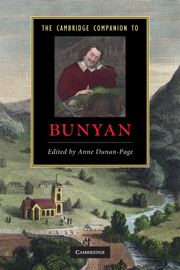Book contents
- Frontmatter
- Introduction
- Part I John Bunyan in his seventeenth-century context
- Part II John Bunyan’s major works
- 5 Grace Abounding to the Chief of Sinners: John Bunyan and spiritual autobiography
- 6 The Pilgrim’s Progress and the line of allegory
- 7 Bunyan and the early novel: The Life and Death of Mr Badman
- 8 Militant religion and politics in The Holy War
- 9 A Book for Boys and Girls: Or, Country Rhimes for Children: Bunyan and literature for children
- Part III Readership and reception
- Guide to further reading
- Index
6 - The Pilgrim’s Progress and the line of allegory
from Part II - John Bunyan’s major works
Published online by Cambridge University Press: 28 July 2010
- Frontmatter
- Introduction
- Part I John Bunyan in his seventeenth-century context
- Part II John Bunyan’s major works
- 5 Grace Abounding to the Chief of Sinners: John Bunyan and spiritual autobiography
- 6 The Pilgrim’s Progress and the line of allegory
- 7 Bunyan and the early novel: The Life and Death of Mr Badman
- 8 Militant religion and politics in The Holy War
- 9 A Book for Boys and Girls: Or, Country Rhimes for Children: Bunyan and literature for children
- Part III Readership and reception
- Guide to further reading
- Index
Summary
Look at the title page of the first edition of The Pilgrim's Progress (1678), and one word stands out, in the largest typeface: 'DREAM.' The full title, with the fullness characteristic of early-modern books, runs as follows, with line breaks marked: 'THE/Pilgrim's Progress/FROM/THIS WORLD,/TO/That which is to come:/Delivered under the Similitude of a/DREAM/Wherein is Discovered,/The manner of his setting out,/His Dangerous Journey; And safe/Arrival at the Desired Countrey'. Between rules there is a quotation from the Old Testament prophet Hosea, 'I have used Similitudes'; and then the author's name (P'sP, opposite p. xxxvi). So it is not strictly a dream, but the 'similitude' of a dream. The carefulness of the distinction, we might think, relates to Bunyan's need to be frank, even defensive, about the relationship between dreams and reality, not to mention the relationship between truth and fiction. However, when it comes to describing life as a passage 'From This World, To That which is to come', the criteria of truth, or of realism, that Bunyan is employing, need to be examined more closely. That there is a real world beyond this one is a more common view in the late seventeenth century than now, but how one got there, and what counted as reliable information about it, was more hotly disputed. Dreams, it appears, give us a privileged entry into a world that is hidden to ordinary perception. The way in which they are interpreted and explained has varied throughout history, of course, but the feeling that there is something special about dreams is equally widespread.
- Type
- Chapter
- Information
- The Cambridge Companion to Bunyan , pp. 80 - 94Publisher: Cambridge University PressPrint publication year: 2010
- 2
- Cited by

